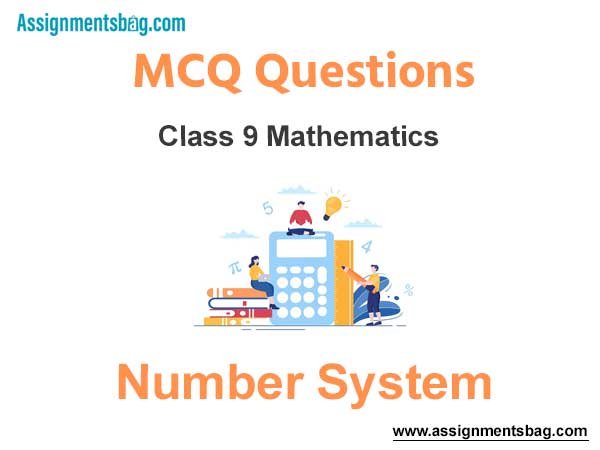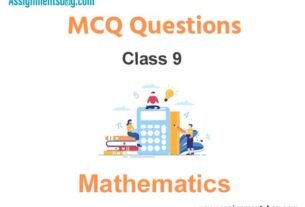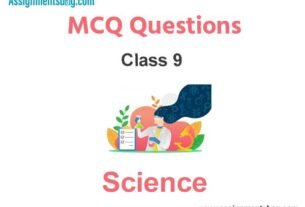Number System Class 9 MCQ with Answers is accessible in PDF format to assist students with reiterating the recently studied lessons before CBSE Board Exam. Thus, MCQ on Number System Class 9 is prepared by our expert teachers who have long periods of teaching experience.
Number System Class 9 mcq is one of the best study materials for students thinking that they are powerful to the point of getting higher marks in an Exam.
Class 9 Number System MCQ are assimilated with appropriate diagrams and compacted in such a way to make certain every detail is covered. You can easily download the MCQ of Number System Class 9 with Answers to improve your preparation before taking the board exam.
Check the below MCQ Questions Chapter 1 Number System Class 9 Mathematics available with PDF free download. MCQ Questions for Class 9 Mathematics with Answers were prepared based on the latest syllabus and examination pattern issued by CBSE, NCERT and KVS. Our teachers have provided below Number System Class 9 MCQ Questions with answers which will help students to revise and get more marks in exams
Number System Class 9 Mathematics MCQ Questions with Answers
Refer below for Number System Class 9 Mathematics MCQ Questions with solutions. Solve MCQ questions and compare them with the answers provided below
Number System Class 9 MCQ PDF downloads have been gathered for students to rehearse. Students can prepare this Class 9 Number System MCQ PDF. Each question has four choices with answers. Firstly, Solve all these Questions and check your answer with the right answer. If your answers do not match with the right answer, Don’t worry try again because You need to prepare daily to score higher marks in the Class 9 Mathematics Exam.
Question. Rationalizing factor of 1 + √2 + √3
(a) 1 + √2 – √3
(b) 2
(c) 4
(d) 1 + √2 + √3
Answer
A
Question. Set of natural numbers is a subset of
(a) Set of even numbers
(b) Set of odd numbers
(c) Set of composite numbers
(d) Set of real numbers
Answer
D
Question. Rationalizing factor of (2 + √3) =
(a) 2 – √3
(b) √3
(c) 2 + √3
(d) 3 + √3
Answer
A
Question. 1/ (√3 – √2) is not equal to
(a) √3 + √2
(b) √2 / (√6 – 2)
(c) (√3 – √2) / (5 – 2 √6)
(d) √3 / (9 – √6)
Answer
D
Question. The rationalising factor of 5 a2b3c4 is
(a) 5√a3b2c
(b) 4√a3b2c
(c) 3√a3b2c
(d) √a3b2c
Answer
A
Question. Four rational numbers between 3 and 4 are:
(a) 3/4, 4/4, 1, 6/5
(b) 13/5, 14/5, 19/5, 17/5
(c) 3.1, 3.2, 4.1, 4.2
(d) 3.1, 3.2, 3.8, 3.9
Answer
D
Question. Value of x satisfying √x + 3 + √x – 2 = 5, is
(a) 6
(b) 7
(c) 8
(d) 9
Answer
A
Question. Which of the following statement is not true?
(a) Between two integers, there exist infinite number of rational numbers.
(b) Between two rational numbers, there exist infinite number of integers
(c) Between two rational numbers, there exist infinite number of rational numbers.
(d) Between two real numbers, there exists infinite number of real numbers.
Answer
B
Question. The value of x , when (2)x+4 • (3)x+1 = 288 is
(a) 1
(b) -1
(c) 0
(d) None
Answer
A
Question. The value of

is equal to
(a) x 1/p+1/q+1/r
(b) 0
(c) x pq+qr+rp
(d) 1
Answer
D
Question. The 100th root of 10(1010) is
(a) 10810
(b) 10108
(c) (√10)(√10)10
(d) 10(√10)√10
Answer
B
Question. If both ‘a’ and ‘b’ are rational numbers, then ‘a’ and ‘b’ from 3 – √5 / 3 + 2 √5 = a√5 – b, respectively are
(a) 9/11, 19/11
(b) 19/11, 9/11
(c) 2/11, 8/11
(d) 10/11, 21/11
Answer
A
Question. Simplify : 2n+4 — 2(2n) / 2(2n+3)
(a) 2n+1 — 1/8
(b) — 2n+1
(c) 1 — 2n
(d) 7/8
Answer
D
Question. Which of the following expressions is same as 1/(3√2 – 1) ?
(a) 3√2 + 1
(b) 3√4 + 1
(c) 3√4 + 3√2 + 1
(d) 3√4 + 23√2 + 1
Answer
C
Question. If x ≥ 0, then √x √x √x =
(a) x√x
(b) x4√x
(c) 8√x
(d) 8√x7
Answer
D
Question.

(a) 1
(b) 2
(c) 1/2
(d) 3
Answer
A
Question. A rational number equivalent to a rational number 19/7 is
(a) 17/119
(b) 14/57
(c) 21/38
(d) 21/57
Answer
D
Question. The value of 0.423 is
(a) 423/1000
(b) 1423/00
(c) 423/990
(d) 419/990
Answer
A
FILL IN THE BLANK :
Question. If x + √5 = 4 + √y , then x + y = ………. . (where xand y are rational)
Answer
9
Question. Two mixed quadratic surds, a + √b and a – √b , whose sum and product are rational, are called ……….
Answer
conjugate
Question. 0.578 is ………. number. (rational/irrational)
Answer
rational
Question. Between two real numbers, there exists infinite number of ………. numbers.
Answer
real
Question. An irrational number between 52 and 73 is
Answer
√6/35
TRUE/FALSE :
Question. Product of a rational and an irrational number is always irrational.
Answer
True
Question. Every integer is a whole number.
Answer
False
Question. All rational numbers when expressed in decimal form are either terminating decimals or repeating decimals.
Answer
True
Question. A real number is either rational or irrational.
Answer
True
Question. Every rational number is a whole number.
Answer
False
Match the following :
Question.
| Column-I | Column-II |
| (P) Decimal expansion of an irrational number is non-terminating and | 1. irrational |
| (Q) The sum of two ………. numbers may be a rational number or an irrational number. | 2. √5 |
| (R) A number x is called a ………. number, if it can be written in the form n m , where m and n are integers, n ! 0 | 3. rational |
| (S) An irrational number between 2 and 2.5 is | 4. non-repeating |
| (T) The value of 0.23 + 0.22 is | 5. 0.45 |
Answer
(P) – 4 , (Q)- 1 ,(R) – 3, (S) – 2, (T) – 5
Question.
| Column-I | Column-II |
| (P) 12 is a | 1. prime number |
| (Q) 2, 7 are | 2. not a rational number |
| (R) 2 is a | 3. composite number |
| (S) √2 | 4. co-prime numbers |
Answer
(P) – 3 , (Q)- 4 ,(R) – 1, (S) – 2
Question.

Answer
P – 4, Q – 1, R – 3, S – 2
Question.

Answer
P – 4, Q – 3, R – 1, S – 2
Question.

Answer
P – (1, 4), Q – 3, R – 3, S – 2
Question.

Answer
P – 2, Q – 3, R – 1, S – 4



